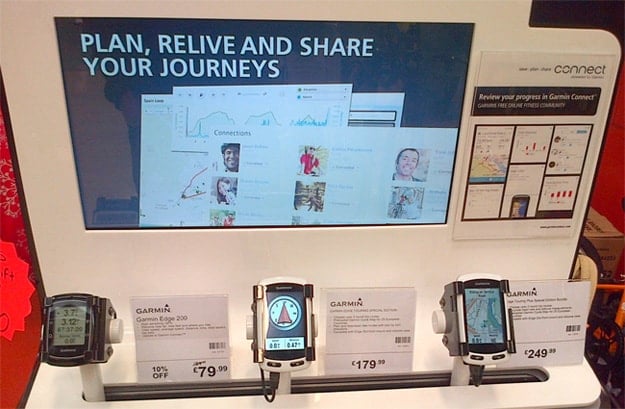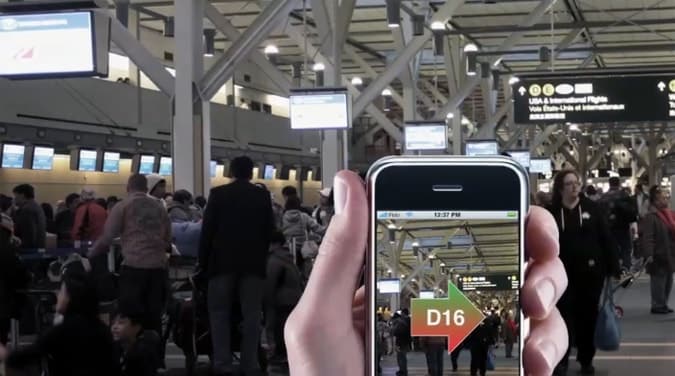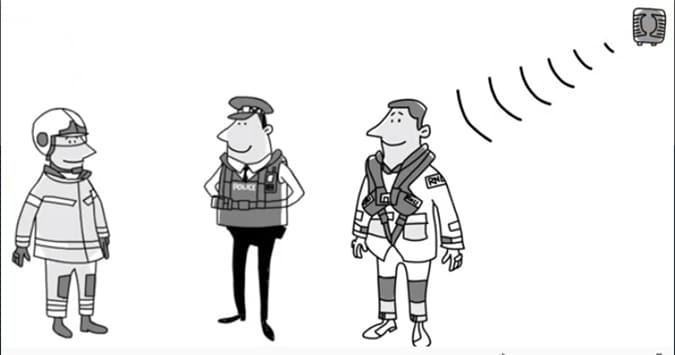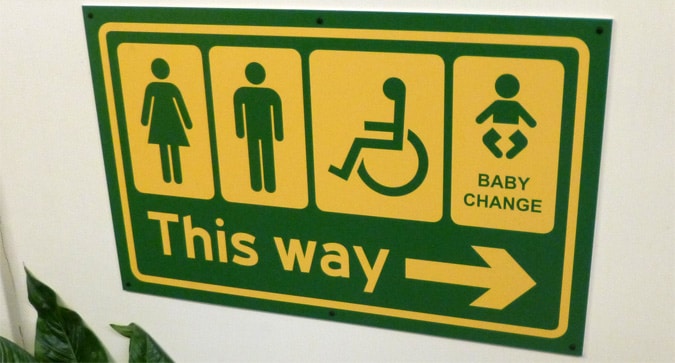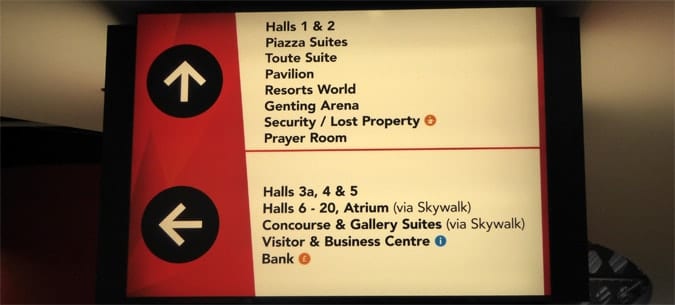Last Updated on June 9, 2023
Digital Airport Signage plays a crucial role at airports. In this blog post, you will learn how digital signage can help an airport to optimally guide passengers through the airport terminal and enhance the overall traveler’s experience.
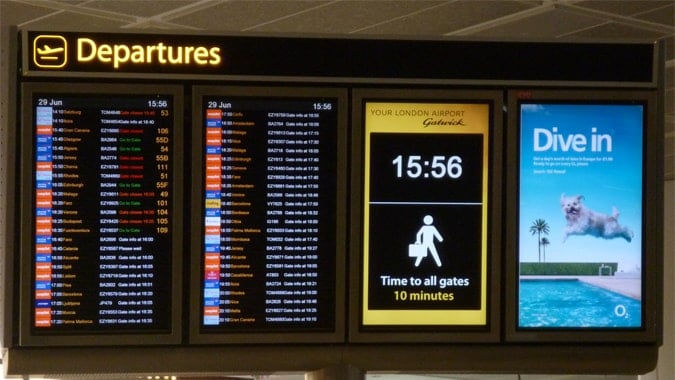
Table of Contents
The importance of good airport wayfinding
Anyone who has ever has been to an airport knows the situation. You arrive at an overcrowded terminal building not really feeling comfortable.
Above everything else, you want to be assured that you are not going to miss your flight.
After checking in, finding your way to the gate is not always clear, the rows at the security are longer than expected, and the public announcement system urgently requesting passengers of other flights to proceed to their gate.
Once you finally arrive at your gate, the flight turns out to be delayed and all your stress was unnecessary.
This shows how important good wayfinding together with up-to-date information can be.
This is not only true for passengers but certainly also for the airport and its airlines.
If travelers do not feel comfortable, they may choose another airport next time.
If passengers arrive too late at the gate then the airline may lose its slot for take-off which can be a very costly affair.
Many airports are aware of the need for good signage, but they do not always choose the right solution.
For instance, a nice-looking App is developed for smartphones, hoping that travelers will install the app and use it.
However, hope is not a strategy and passengers do not let themselves be pushed into an active role to solve the wayfinding problem of the airport.
So the airport needs to look for an alternative solution.
From Static to Dynamic – Digital Airport Signage
Of course, it all starts with static signage, and having static signage in part is essential, as you will appreciate if you have read the Gatwick story and what happens when electronic signage fails.
This signage needs to be clear, and consistent and must be placed at strategic positions in the airport to prevent any misunderstandings.
However, as the name already indicates this signage is static which means that the possibilities are limited.
It doesn’t enable an airport to quickly respond to situations that ask for different signage.
The solution for this is to switch over to dynamic signage using digital screens.
The usage of digital screens for showing information is called digital signage. But digital signage is not just the digital variant of static signage. It’s much more.
Nowadays we are fed an enormous amount of information, on request but also unsolicited. It’s very difficult to sort out all this information and filter the exact information we need.
That’s exactly what digital signage is all about: offering the right information at the right moment by using digital screens.
Many screen manufacturers offer professional displays for digital signage.
The key players are Samsung, LG, NEC, and Panasonic. Apart from the display’s software plays an important role in digital signage.
In most cases, the software determines the (im)possibilities of the digital signage solution. Globally there are many suppliers of digital signage software.
Some major advantages of digital signage are:
- Reduced costs – The initial investment costs of digital signage are substantially higher, but when looking at the total costs of ownership (TCO) the long-term costs will be lower.
- Dynamic, targeted content – The content display possibilities are nearly unlimited. By linking to existing databases or sources on the Internet one can include up-to-date, dynamic content like news feeds, social media posts or even live TV.
- Content can simply be updated – Ad-hoc changes can be made visible instantly.
- The audience can be steered – An important but often overlooked reason for an airport to consider digital signage is the possibility to influence passengers in their decisions. Not only as a tool to dynamically guide them through the airport, but also to influence purchase decisions with targeted advertising.
The most well-known example of digital signage at an airport is, of course, a FIDS (Flight Information Display System), which you will find at nearly every airport nowadays.
It shows you real-time flight information including the allocated check-ins and gates. But things can be much smarter.
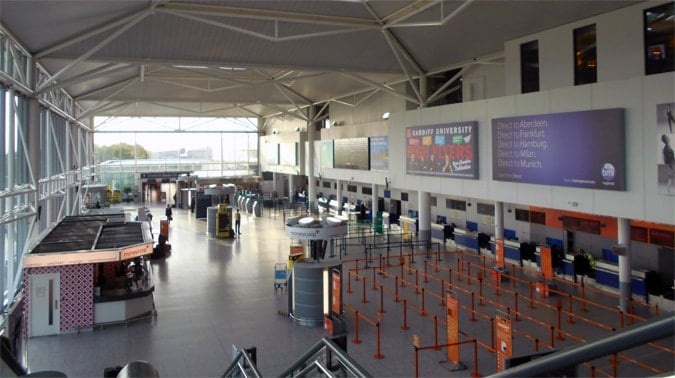
Making airport wayfinding smart
By adding more intelligence an airport can optimally exploit the potential of digital signage.
It enables an airport not only to enhance the passenger experience but also to steer the passenger flows at the airport and influence the decisions a passenger will make in specific situations.
With targeted advertising, one can even generate additional revenues.
Some examples:
Targeted Information
By expanding the content of the departures screens with direction arrows and information about walking distances passengers no longer have to search for static signage after consulting the screens.
With targeted information on the screens across the airport, the passenger can be dynamically guided to the gate. If the ‘regular’ route to the gate is blocked or a certain area of the airport is overcrowded, passengers can be dynamically rerouted by adjusting the displayed wayfinding information.
Instant Changes and Dynamic Information
On their way to the gate, passengers can be steered in their decisions. In case of a gate change, for instance, the signage can be instantly adjusted to show the right directions.
If there is a significant delay an offer of the coffee bar together with arrows showing the right direction can automatically pop up on the screen.
This way, dull waiting moments at the gate can be turned into additional business for the bar.
Providing Information for the next section of the journey
At the baggage belts, passengers who are waiting can already read information about the visa procedure they can expect and the possibilities they will have for public transportation when leaving the airport.
In case of an emergency situation, all screens in a certain area of the airport can automatically be used to show instructions and information on how to find the nearest emergency exit.
The Future
New technologies such as audience recognition, I-beacon and NFC make it possible to communicate with the passenger even more targeted and personalized.
To give an example, it’s already possible with WIFI technology to determine the nationalities of people at a waiting area and adjust the content on the screens to it.
There is no doubt that in the next couple of years you will see more examples like this.
Dr Paul Symonds has a PhD in Wayfinding from Cardiff Metropolitan University in the UK. Paul works with the signage industry, airports and other locations providing wayfinding audits, consultancy and training.

